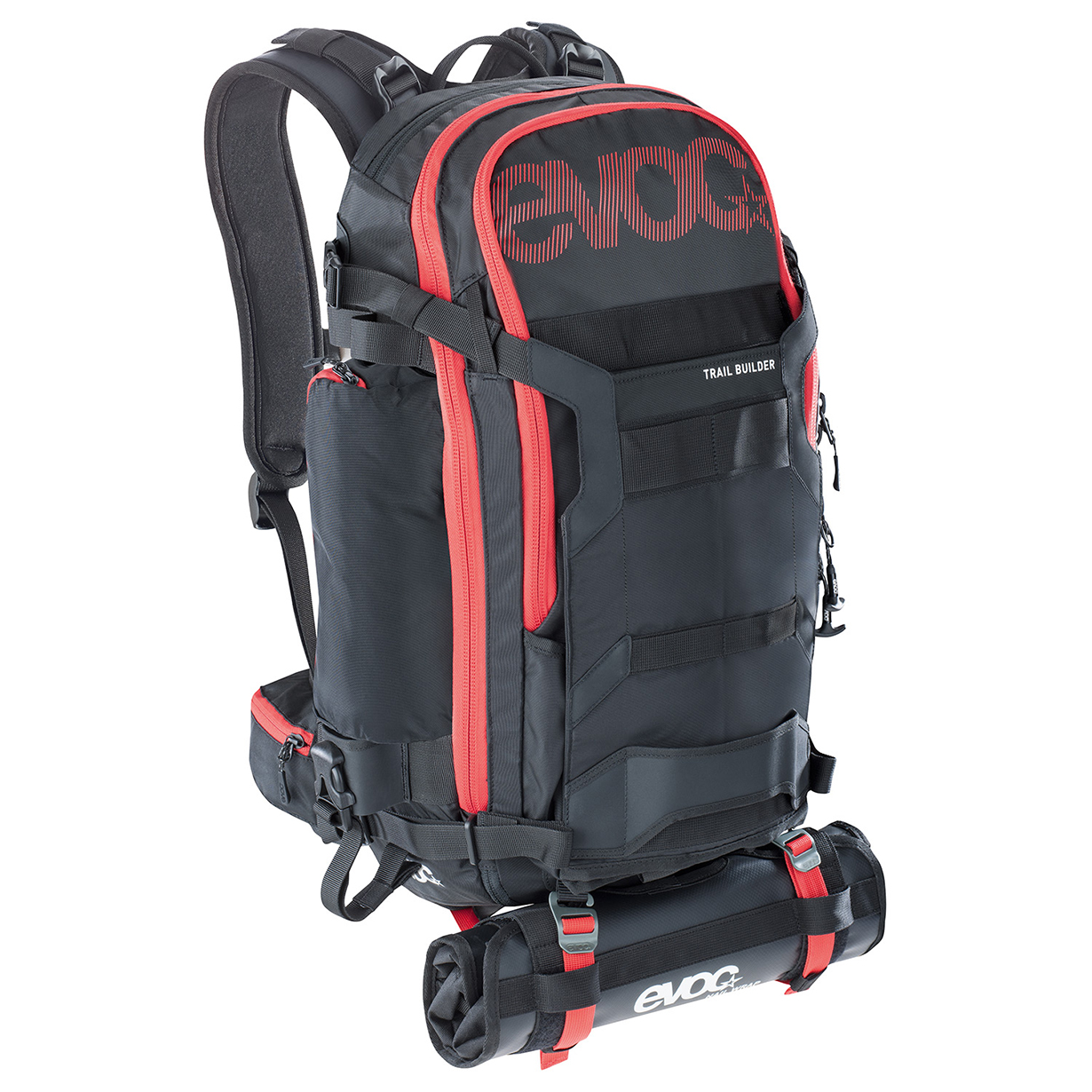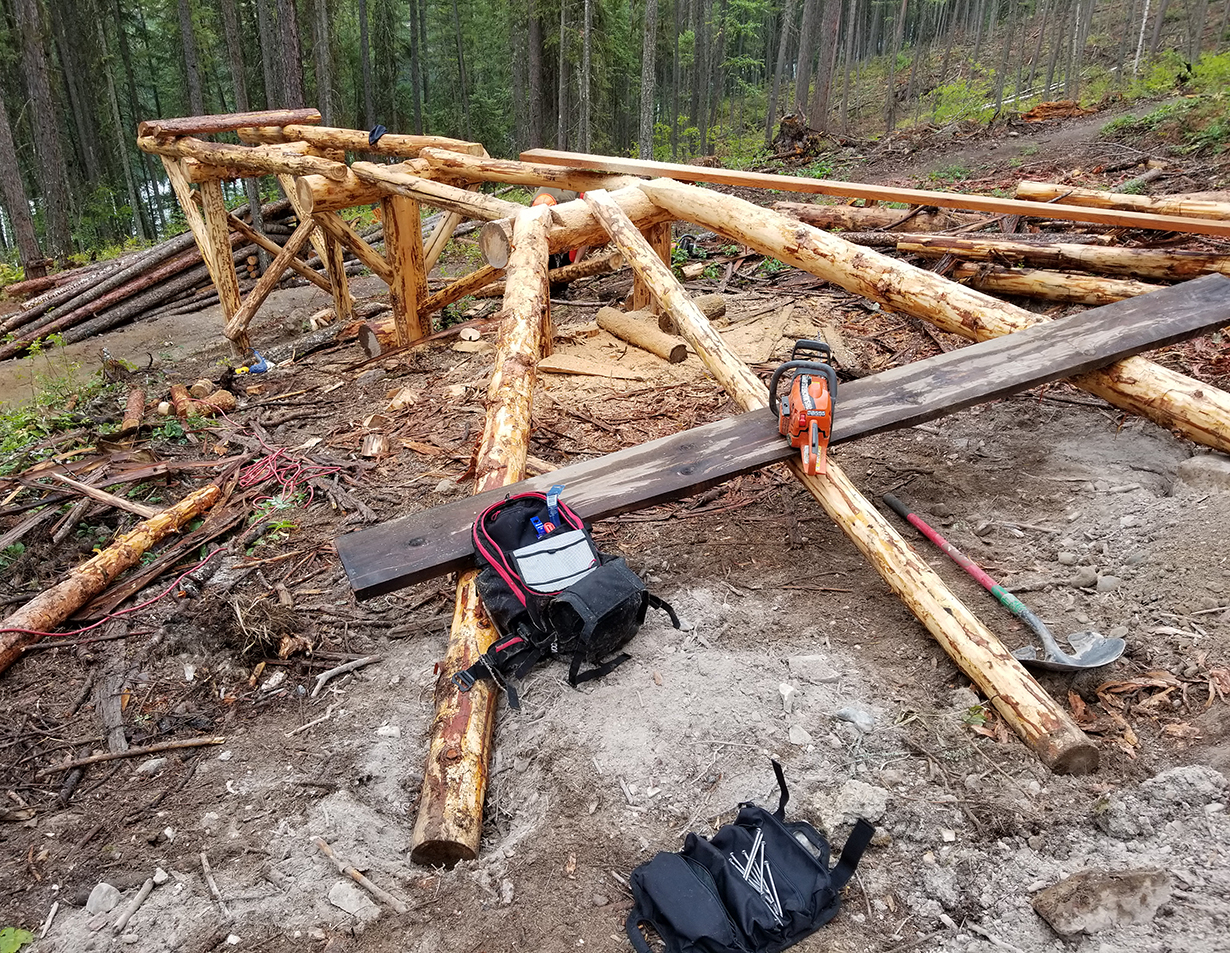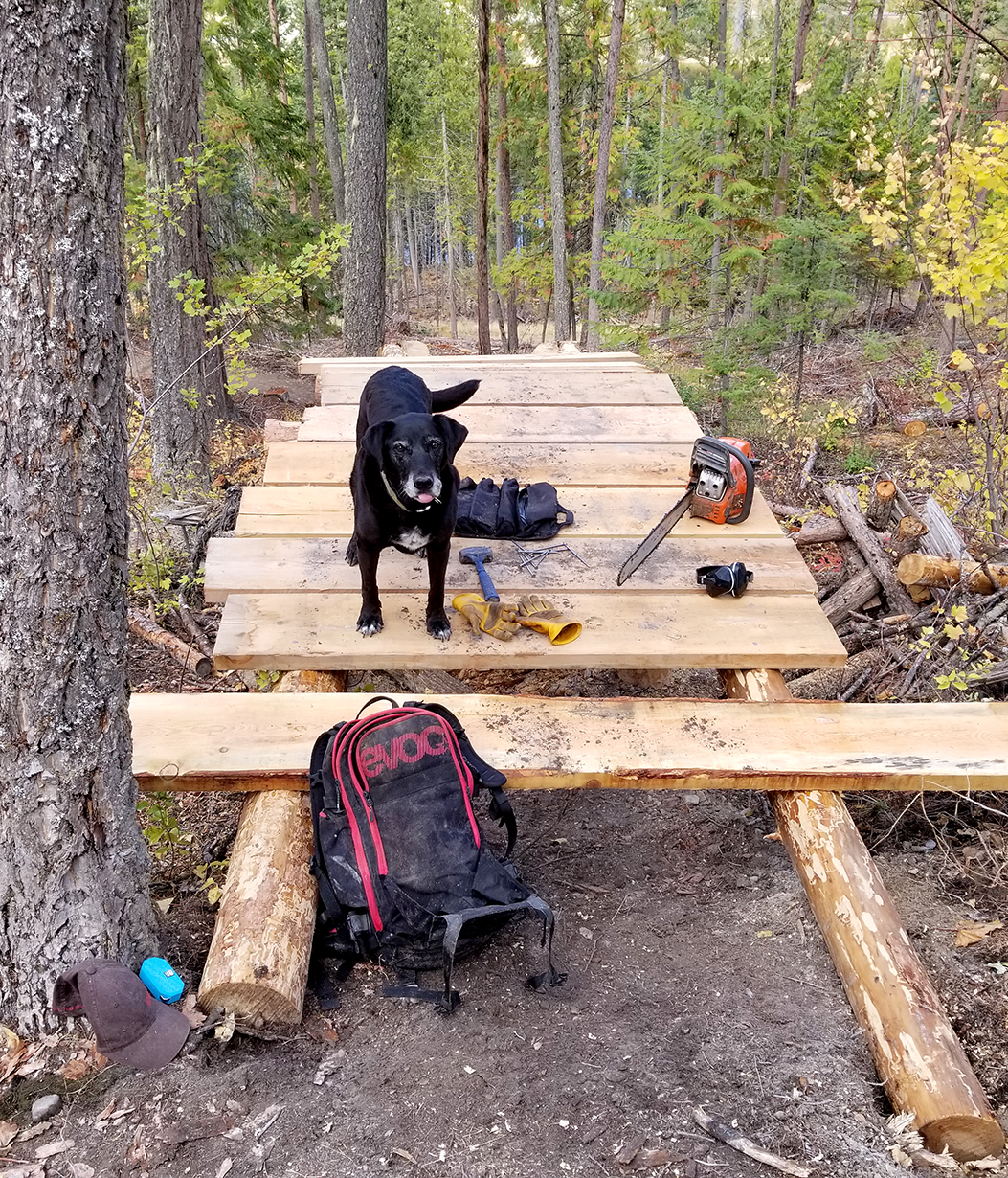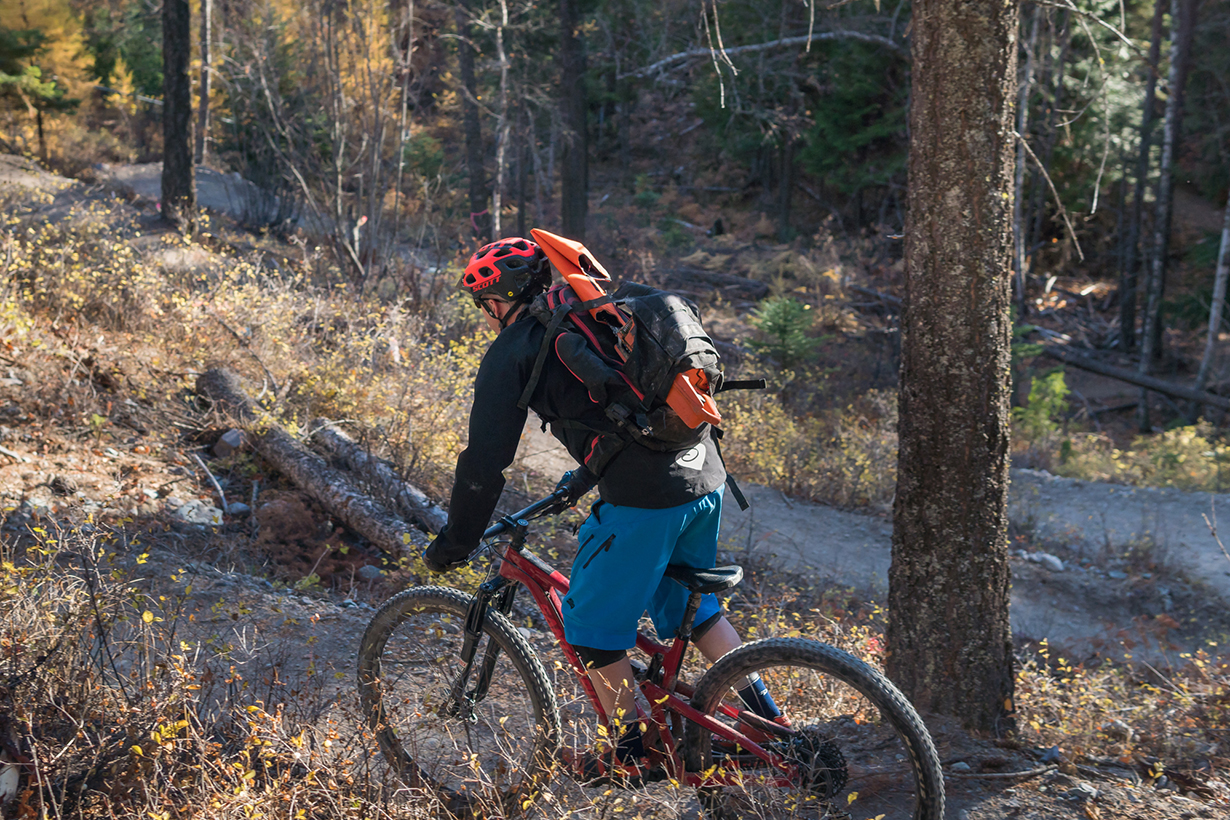
Evoc Trail Builder Pack
Stated Volume: 30 liters
Stated Dimensions: 29 x 56 x 18 cm
Blister’s Measured Weight: 1740 grams (pack only — no nail roll)
Stated Features:
- Attachment system for: axe, hammer, hedge clipper, chainsaw, protectors (storable)
- Nail wrap (separate, stowable)
- Hip belt pocket
- Key holder
- Rain cover
- Sunglasses pocket
- Tool compartment
MSRP: $250
Test Location: Whitefish, MT
Test Duration: ~4 months
Intro
Good bike trails take maintenance. Hell, even bad bike trails take maintenance. But carrying all the gear to carry out that maintenance can be a bit of a chore. Enter Evoc’s Trail Builder pack, which is designed to carry a good chunk of the gear you might need to bring along for trail building, clearing, and maintenance.
Construction
The main pack is made out of polyurethane-coated 1000-denier Cordura, with some areas reinforced with 600-denier fabric. The polyurethane coating provides some degree of water resistance, and also helps keep dirt from getting ground into the fabric. Quite a few areas on the pack are reinforced with an additional rubberized fabric, particularly around the chainsaw carry.
The main zippers are big, heavy things, and in a nice touch, the pulls are different shapes so it’s a little easier to know which zipper opens which pocket at a glance. The zippers for smaller pockets aren’t quite as burly, but they’re still high-quality.
On the inside of the pack, some of the smaller pockets are created with a plastic-y fabric that should keep the contents dry short of full submersion. There’s also a separate zippered compartment at the bottom of the pack that’s coated in a tarp-like material that, again, will keep the contents dry in most situations.

Most of the straps are normal 1” webbing with good quality plastic buckles. The exceptions here are the straps for attaching things to the bottom of the pack (like the nail roll), which are ¾” and have metal clips, and the waist belt, which is 1.5” webbing, and the main buckle is metal.
The pack has a plastic frame of sorts in the back panel, coupled with some foam ribs. This does a pretty good job of helping the pack keep its shape, even when it’s not fully loaded. And more importantly, it helps keep the load distributed evenly while wearing the pack while also conforming nicely to my back. The foam ribs also help a bit with airflow back there.
Features
There’s a ton of features in this pack, and given that the idea here is to carry a bunch of different stuff efficiently, I’ll break this section down a little bit.
Features Designed Around Carrying Tools
The most obvious one here is the chainsaw carry. I’ve carried a few different saws in this pack, all of which happened to be Husqvarnas, and with bars ranging from 16” to 24”. All of the saws fit into the pack without issue, and there’s 4 straps to dial in fit. The two top straps release with a basic buckle, and they’re the ones that really hold the saw into the pack. The bottom straps cinch the saw down, and they help keep the bar rocked away from the back of my head (which works pretty well, even if there’s not much else in the pack).
On both sides of the pack there’s a loop and buckle that works for axes, pulaskis, etc. The head of the tool sits right at your hip, so if it’s anything sharp you’ll obviously want a cover on it. Tools with wider heads (e.g. a Rogue 5” McLeod) won’t fit, and they’d end up being pretty annoying to ride with in that location. It’s also worth noting that the left side of the pack has a water-bottle-sized pocket, and strapping a tool on that side of the pack doesn’t work well if there’s anything substantial in that pocket.
There’s a loop on the back of chainsaw carry panel that works well for carrying clippers, but some extra straps are needed to secure things well. But in that regard, there’s a ton of tie-down points and loops of webbing, so figuring how to strap some random object to the pack is generally pretty easy.
There’s also the built-in straps that work well for attaching anything to the bottom of the pack. They’re designed with attaching the nail roll in mind, but if you’re not bringing that along, they’d work well for attaching other stuff too. Tools don’t work quite as well here though, since the strap places the tool horizontally.
And speaking of the nail roll: it’s included with the pack, it has three compartments that are long enough to fit 10” spikes / lag screws, and it’s built out of a burly material that holds up well.
Features Designed Around Carrying Things Other Than Tools
Here’s the pocket breakdown:
• 1 big main compartment, and inside that compartment is:
• a hydration bladder sleeve
• a mesh pocket with a lanyard for your keys or whatever
• 1 medium-sized secondary compartment, and inside that compartment is:
• 2 open sleeve-type pockets
• a regular zippered pocket
• a water resistant zippered pocket
• a water resistant velcro pocket
• 1 fleece-lined glasses pocket that’s big enough to fit goggles
• 2 pockets on the hip belt (one on either side)
• 1 side water bottle / fuel can pocket
• 1 water resistant pocket at the bottom of the pack, with an access zipper into the main compartment
• 1 stash compartment at the bottom of the pack where straps can be tucked, and which holds the rain cover.
Evoc calls this a 30 liter pack, and that seems pretty accurate based on other 30ish liter packs I’ve used. Liter estimates can be a bit deceiving, especially on packs that are broken down with a bunch of different pockets, but the Trail Builder can hold a fair amount of stuff. I would say, however, that the pack doesn’t really expand or compress as efficiently as some packs, so if you’re really trying to jam it full with big items, that can be a chore.
Here’s a picture with the a normal assortment of stuff that you might put in the pack, and with everything pictured loaded into the pack. It’s missing a few obvious items (first aid kit, some bike repair tools), but everything here fits with room to spare.

Other Features
As I noted above, the back panel has a flexible plastic form in it that gives the pack some shape, but also conforms nicely to my back. The foam ribs on the back are shaped to provide some extra breathing room across the middle of the back, which probably helps a little with ventilation. That said, I wouldn’t call this a heavily ventilated pack — it’s more designed with carrying heavy loads in mind.
The shoulder straps are fairly average in terms of both width and padding. There’s enough padding to give them good form and keep them comfy with some weight on them, but they’re not thick or bulky. Like most quality packs these days, there’s load lifters to let you dial in fit, especially with the pack loaded down. There’s also a traditional sternum strap with a built-in emergency whistle.
The pack includes a bright red rain cover that pulls over the pack, although it doesn’t really fit with any large tools strapped on. In a nice touch, the rain fly doubles as a warning sign — it has “Trail Builder at Work” printed on it.
On the Trail
Riding with the Trail Builder, loaded down with normal gear and a chainsaw, is actually surprisingly comfortable. The hip belt takes a good amount of the weight, even when on the bike, and a bit of trial and error with the straps kept the chainsaw tightly situated.
Particularly with a bigger full-face helmet on, I was initially a bit worried about the saw bar smacking me in the back of the head, but it wasn’t too hard to adjust the straps to keep that from happening. And I also expected the pack and the saw to swing around a bit, but it really wasn’t an issue.
Here’s a quick video (filmed by Ryan Liem-Salime) of me riding a downhill trail with the pack on. It’s a reasonably steep, technical trail, but riding with the Trail Builder with a small saw in it really didn’t make all that much difference.
The point there is that you can go for a ride with this pack and still be able to actually ride a bike in a semi-active manner. But for longer rides that don’t necessarily involve technical trails, the issue is mostly just the weight. The Trail Builder carries the weight about as well as you could expect, but at the end of the day, it can get tiring, especially if you’re packing a bigger saw.
Things I’d Change
The Trail Builder is a very solidly-constructed pack, and there’s no question it’s well thought out. There aren’t any major problem areas that I’ve discovered, but there are a few things that I think could be improved.
The first and most obvious is that there’s no pass-through hole for a hydration bladder hose. There’s a sleeve for the bladder, and there’s loops for the hose on the shoulder straps, but I haven’t found any way to route the hose other than through the zipper.
A somewhat less obvious improvement is that I’d like to see a better pocket or compartment made for carrying fuel and bar oil for the saw. Maybe something with a rubberized coating that’d hold up well to getting nasty liquids spilled on it. I’ve gotten some gas and oil on the pack and the Cordura seems to shrug it off fine, but it’d be nice to have a dedicated pocket for it, preferably that could be cleaned up with a quick wipe.
A Comparison
Chainsaw-carrying trail-building packs are obviously a niche item. Niche-y enough that there are basically just two packs on the market that are really designed for riding bikes while carrying a saw. So, how does the Evoc Trail Builder stack up against the Dakine Builder Pack 40L?
In terms of construction, I’d give a nod to the Evoc for burliness. The fabric is a bit heavier than the Dakine, there’s more reinforcement of the stitching, and the fabric is doubled-up and/or rubber-coated in lots of areas, which the Dakine doesn’t have. Some of the Dakine’s buckles are a bit beefier though.
In terms of carrying a saw, the two packs are fairly similar, although the Dakine secures the saw with three straps whereas the Evoc uses four. For big saws, that might mean getting everything secured is a bit easier with the Evoc.

But the biggest difference is mainly the size and layout of the pack — the Dakine is, overall, a higher-volume pack. The main compartment in the Dakine has quite a bit more space than the Evoc. The main compartment in the Dakine is also a top loader with back panel access, while the Evoc just has the two, traditional zippered compartments. However, the secondary compartment in the Evoc is a good bit bigger than the secondary compartment in the Dakine (although it’s not big enough to overcome the overall size difference — the Dakine is still bigger).
In terms of fit, the Dakine is a bit shorter, but it’s deeper. So, the fully loaded Dakine pack will stick out further off your back, which might feel a bit unwieldy while riding. The Evoc pack is taller, and a bit slimmer when fully loaded. I think the Evoc rides better since it keeps the weight closer to your back, but it might not work as well for shorter people. The Dakine has a more substantial waist belt, which is probably comfier in the long run for taking weight off of the shoulders. The Dakine’s back panel is also slightly stiffer (although smaller), so it probably does a bit better at distributing loads. The shoulder straps are a little wider on the Dakine, although I’m not sure it’s enough of a difference to really matter.
Some other notes: both packs come with a nail roll that are pretty similar. The Evoc has more waterproof pockets. The Evoc has a soft goggle / glasses pocket, but the Dakine does not. The side pockets on the Dakine are bigger, and fit fuel bottles better than the Evoc. The Dakine has two side pockets, while the Evoc only has one. That’s good for carrying stuff in the pockets, but it might make strapping certain tools onto the side of the Dakine a bit trickier. The Evoc has the pocket at the bottom of the pack, which the Dakine does not. The Evoc also has the straps at the bottom of the pack, which the Dakine does not (although the Dakine has tie-down points there, so you could use your own straps).

Overall, I’d pick the Evoc in terms of comfort while riding, and I’d expect the Evoc to hold up better over time. The fact that the Evoc is a bit taller and slimmer makes it a bit less unwieldy to ride in. But the Dakine wins out in terms of carrying capacity — it’s just a bigger pack, and I’d give it the nod in terms of carrying big, heavy loads.
Bottom Line
I like going for bike rides, but I dislike bike rides that are wasted on hiking over lots and lots of downed trees. Rather than waiting around for someone to do the work for me, I’d rather put the time in and fix the issue myself. There’s a certain satisfaction in clearing a trail and opening it up for everyone to enjoy. And if you’re doing it right, someone will buy you some beer for doing it.
The Evoc Trail Builder pack makes the whole process of trail clearing and maintenance a lot more pleasant. It carries everything I need, and it’s surprisingly comfortable to ride in. All things considered, if I’m going to have ~25 lbs of stuff strapped to my back, the Evoc does a fantastic job of keeping it situated and making it so that I can still enjoy the ride. And it does so in a package that’s built with longevity in mind, so I expect it’ll hold up well to years of abuse.

Hay Noah, thanks for the detailed and thoughtful review. I was looking for a good side-by-side of these two packs, and your comparison section is real helpful.
Thanks for the in depth review. I was looking to buy a trail builder pack and couldn’t decide between the two. Your review helped me make my decision.
Thanks Noah – just received mine today – lots of deadfall to deal with this spring. Appreciate your review!
Hey Noah!
Thanks for the review. I have a Stihl MS 270 with a 20″ bar. Not a small saw by any means. Which of the 2 would you recommend? As an added detail, I am 5’5″ and I don’t go for “rides’ while fixing trail. Rather riding to the specific areas.
Thanks! Happy Trails!
Thanks for the detailed review
My stronger (and younger) trail building buddy could probably use the Dakine for his chainsaw and carrying rocks in that bucket holder
I’m carrying a bunch of trail boss tools but no chainsaw so the Evoc makes sense.